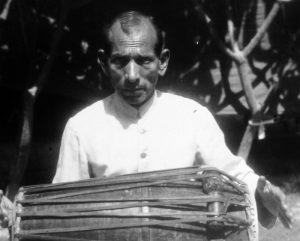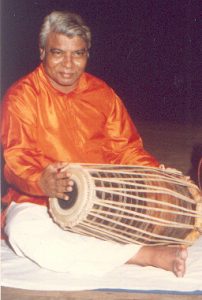| Told by | Sri Debabrata Mukhapadhyay |
| Obtained by | Rajeswary Ganguly Banerjee |
| Date | 28th September, 2016 |
| Place | Residence of Sri Debabrata Mukhapadhyay at Tarashankar Sarani, Tala, Kolkata |
| About the speaker | Associated to All India Radio, Kolkata. He presented several eye-opening discussions on Indian classical music. A poet, writer, and music connoisseur. |
| Tags | Nitai Bose, Mustaq Ali Khan, 1965, Arjun Shejwal, Pakhawaj, Akashbani, Rabindra Sadan, Ajodhya Prasad , Pratap Narayan Mitra, Fahimuddin Khan Dagar, Enayat Khan, Stretched Membrane Instrument, Frequency, Baya, Dhrupad |
| Language | Bengali |
Sri Debabrata Mukhapadhyay Speaks :
Text Version:
Nitai Basu, the disciple of Ustad Mustaque Ali Khan, was a very learned, gentleman and his house was an abode of classical music performed by masters. He liked me a lot and came to visit me often. He didn’t like my way of comparing musical notes with mathematics yet we got along fine. It was in 1965 that I heard Arjun Sejwal’s solo Pakhwaj performance.

I had heard Pandit Ayodhyaprasad and Pratap Narayan Mitra’s pakhawaj but it was quite another experience to hear Arjun Sejwal. Later I came in contact with Ustad Fahimuddin Khan Dagar, but it was another story. Anyway, I was a bit sceptical about solo performance of pakhawaj but it was an opportunity to watch this quite closely, so I went. Arjun Sejwal was not looked like an artist rather he had the physic of a wrestler. His wrist was mascular and strong. It was a tradition in classical music in our country that pakhwaj players must learn wrestling well because they had to carry almost 60 kg weight of their instrument. But his smile was beguiling; he was quite young then, 35 years maybe. The performance was was quite homely and simple. It all happened in a small room of Nitai Basu’s house. Here I first watched the astonishing job of putting whole wheat in a pakhwaj. Pakhwaj is an Indian instrument with stretched membrane loaded at the centre (if I may use the physics jargon). Pakhwaj had a very low tonal quality basically and a thick layer of whole wheat (atta) had to be used. When the left side of pakhwaj was being played it gives a very bass sound and it prepared the serious atmosphere for Dhrupad.

Arjun Sejwal played this difficult instrument so easily as if he was doing nothing. A smiling face and his hands flew with practised ease it was a feast to the eyes. The beauty of music is not only in listening but also in viewing. In our ancient script it was written about knowing the soul. Soul is omniscient, so how one can understand one’s soul. So, you should think about it, listen to it, view it and meditate it, the perfect mix of all the external experiences will lead you to know your soul. I think, Indian classical music is just like that.
Translation by: Arundhati Banerjee
Picture Courtesy: Google
Edited & Designed: Ms. Rajeswary Ganguly Banerjee
Data processed at SAP-DRS Lab, Department of Instrumental Music, Rabindra Bharati University.
